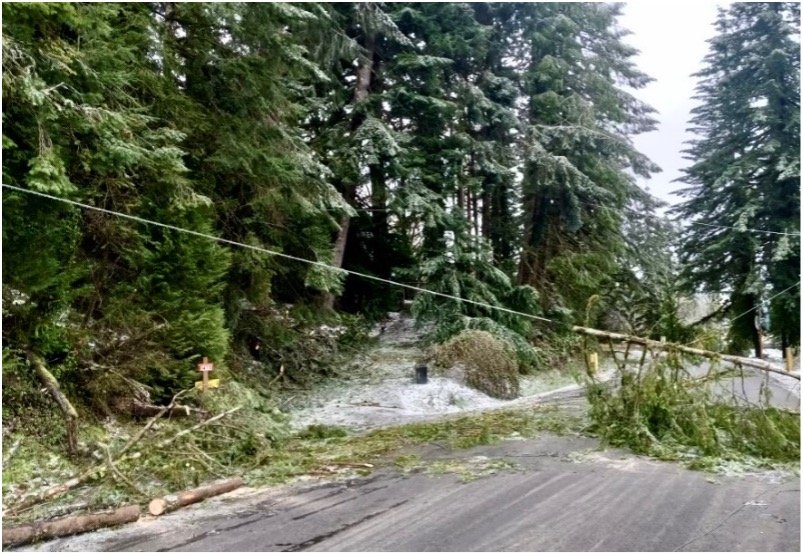Climate Change Effects on the Energy System
Oregon’s Changing Climate
Climate change may affect the reliability of the region’s energy system. Increased frequency and intensity of extreme weather can affect energy facilities and transmission lines, threatening the reliability of the energy services Oregonians need.
From deadly heatwaves to severe storms to increased wildfire risk, Oregon is no stranger to the negative effects of climate change. In the Oregon Climate Change Research Institute’s Sixth Oregon Climate Assessment, the institute described how climate change is already contributing to extreme heat, drought, wildfires, coastal erosion, and other erratic weather conditions and hazards in Oregon. Read full “Climate Change Effects on the Energy System” section
Downed trees and power lines in Lincoln County in January 2024.
Over the past 70 years, the number of extremely warm days increased significantly across Oregon, leading to increased energy demand for cooling buildings. In addition addition to climate change causing temperatures to increase, it is also causing precipitation extremes to increase.
Extreme heat presents a growing threat to Oregon’s communities and its natural environment. In fact, in the past five and a half years, Oregon’s Governors have issued 97 emergency declarations requiring response to extreme weather-related events in the state.
Energy System Climate Impacts
Most of Oregon’s greenhouse gas emissions come from the energy used every day, including electricity, direct use fuels, and transportation fuels. Five main economic sectors – transportation, commercial, residential, industrial, and agricultural – contributed about 61 million metric tons of carbon dioxide equivalent in Oregon in 2021. For context, Oregon’s greenhouse gas emissions should be 3 million MTCO2e or lower by the year 2050 to meet the Oregon Climate Action Commission’s recommended goals.
Energy remains Oregon’s largest emitter of greenhouse gases, accounting for over 83% of Oregon’s 2021 emissions. These gases contribute to climate change, which in turn affects Oregon’s energy systems. A changing climate can shift energy demand, alter energy supply, increase energy costs, and have many other effects on the sector. Unless global greenhouse gas emissions decline considerably, the effects of climate change on Oregon’s way of life will intensify over the coming decades.
The energy sector plays a unique and important role in climate change – it can be a cause of climate change, can be affected by climate change, and can also be part of the solution.
Energy Demand
Portland General Electric reports that extreme weather has become more common, “driving unprecedented hourly peaks that can require every available energy resource to meet demand.”
Extreme heat presents a growing threat to Oregon’s communities and its natural environment. Over the past 70 years, the number of extremely warm days increased significantly across Oregon, leading to increased energy demand for cooling buildings.
In June 2021, a record-shattering heat wave caused at least 96 confirmed deaths in Oregon. That summer was the hottest in Oregon’s recorded history, and climate change is projected to increase the duration, intensity, and frequency of extreme heat events in the state.
These warmer temperatures and more frequent heat waves have created new summer peaks in electricity demand to meet additional cooling needs in homes and workplaces. This puts stress on Oregon’s current electricity systems and creates challenges for utilities to meet demands.
If greenhouse gas concentrations do not decrease, the frequency of heat events as extreme as the 2021 heat dome is expected to increase from once every 1,000 to 100,000 years to once every six years by the end of the century.
Equity and Actions to Mitigate and Adapt to Climate Change
Percentage of Oregon Households Considered Energy Burdened by County More: County Profiles
Climate change has a disproportionate effect on certain communities—particularly environmental justice communities, communities of color, and low-income, rural, and coastal communities—that have been traditionally underrepresented in public processes and typically have less access to resources for adapting to climate change.
In Oregon, the median household income for people of color is about 30% less than for white households, and people of color and low-income households across the nation have a disproportionally high energy burden—the percentage of income spent on energy costs—compared to other households.
In the transition to a clean energy future, there is a renewed effort to ensure those communities are not left behind. The historic federal investments of the Infrastructure Investment and Jobs Act and Inflation Reduction Act include President Biden’s Justice40 initiative, which requires that at least 40% of the benefits of climate and clean energy investments flow to disadvantaged communities and Tribes, as defined in the Climate and Economic Justice Screening Tool. ODOE will be implementing the Justice40 Initiative in its planning for federal programs to ensure disadvantaged communities and Tribes benefit from these programs that fight climate change and deal with the effects.




